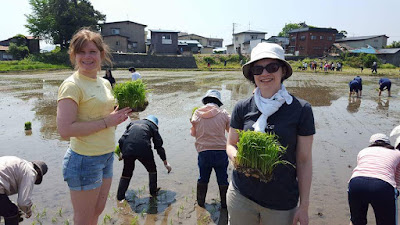春暑し - haru atsushi - summer-like late spring weather
Just as the cherry blossoms were disappearing from the trees in the park, the apple blossoms were blooming in all the orchards around Hirosaki. Apple Park held the Ringo no hana Matsuri (Apple Blossom Festival) in mid-May, complete with shamisen performances, fresh-pressed (squeezed?) apple nectar, the sweet fragrance of apple blossoms carried on the breeze... and bees.
 |
| Mt. Iwaki from the scenic viewpoint in Apple Park |
 |
| Fragrant apple blossoms everywhere |
 |
| Up close and friendly with apple blossoms |
We went on the first Sunday, in time to watch my shamisen senpai play on the stage in the shade-tent. After that, we took in the view of Mt. Iwaki from the viewing platform on the hill and admired some apple blossoms up close. There was a small tent near the entrance to the visitor center, where a man and a woman were feeding apple slices into a food processor to make apple nectar on-demand, for 300 yen per cup. Delicious apple essence.
2015 田んぼアート - tanbo aato - Rice field art
I see that I never mentioned the 2015
tanboaato (rice field art), that I saw last August when I had recently arrived. One day in the afternoon, during the summer break, my supervisor came to my desk and said "I'll take you to see the rice art" or something like that. So we got into his minivan and drove about thirty minutes out to Inakadate, with the AC off and the windows rolled up. A few miles before you reach the second viewing area on highway 109, there is a digital sign overhead that announces the air temperature. I remember it read above 30 degrees Celsius that day. We were both in office clothes, and I was wearing long trousers and a blouse that I had just discovered was very bad for hiding sweat. Although I nearly got heat stroke, the rice art was very pretty to look at from the viewing towers.
 |
| 2015 Inakadate Rice Field Art - Site #1, Star Wars: The Force Awakens |
 |
| C-3PO and R2-D2 Rice Field Art |
 |
| This is what C-3P0 looks like from ground level - purple and yellow rice |
 |
| Diagram showing the 7 colors of rice plants used to make the art |
 |
| 2015 Inakadate Rice Field Art Site #2 - Gone With the Wind |
 |
| Another image seen from the tower- it says "A person who was regretfully lost" |
 |
| Mountain view over the rice fields, from the tower at Site #1 |
2016 田植え - taue - Rice Planting
This year, I saw a notice somewhere about volunteering to help plant this summer's rice art, and signed up along with some other Hirosaki folks. On a lovely morning at the end of May, we headed out to Inakadate to plant some rice.
First all the volunteers gathered behind city hall to hear some pronouncements by local officials and do some warmup stretches in the form of a silly dance to a song about rice (
Kome kome kome kome kome) led by Komechan the
Yurukyara rice grain.
 |
| Crowd of volunteers behind City Hall |
 |
| Waiting for the opening remarks - photo credit to Sarah Q. |
 |
| Komekun the Purple Rice Grain and Ikube Aomori mascots with city officials |
Then, with no sort of planting instructions provided whatsoever, in English or in Japanese as far as we could tell, all attendees marched out into the field. Everybody smiled and nodded at us, and otherwise we were completely ignored. This happens sometimes. It seemed as if rice seedlings had just magically appeared in everyone else's hands. Eventually someone came by and put a square tile of rice seedlings on the edge of the field and walked away. We picked an empty row in the field and started sticking seedlings into the mud.
 |
| Rice seedlings waiting next to the unplanted field |
 |
| Modeling the rice seedlings - photo credit to Sarah Q. |
 |
| This is the flattering rice-planting position - photo credit to Sarah Q. |
 |
| Done with our rows of rice - photo credit to Sarah Q. |
 |
| The field is mostly planted |
 |
| The yellow twine separates the different colors of rice for the image |
After about an hour our rows were full, we had no more seedlings to plant, and the small army of middle school volunteers was finishing up the field. We rinsed our muddy hands and feet in the clean water running through the trough at the edges of the field and went back to city hall for our tonjiru and onigiri (pork soup and rice balls).
Despite having a great time planting rice as part of the rice art effort, I never actually made it out to see the art after it matured... ugh. I want to plant the rice again and actually go see the art next time!



















No comments:
Post a Comment